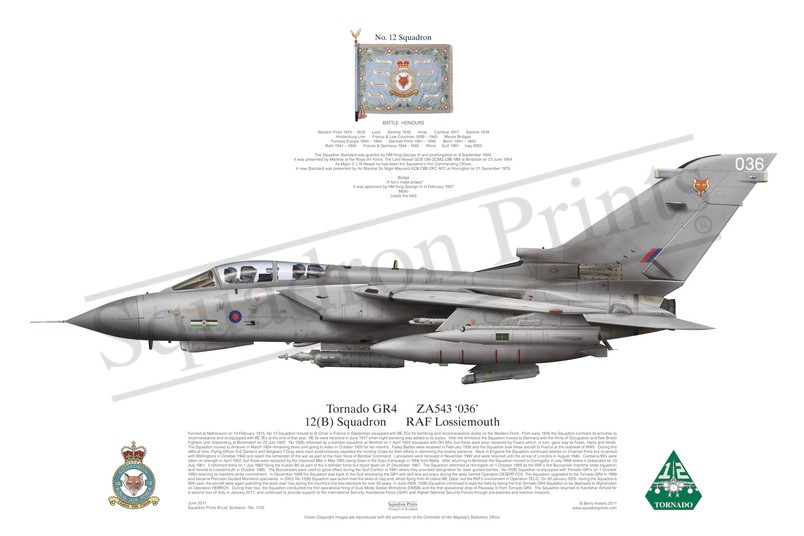#1122 Tornado GR4

Purchased products will not feature the Squadron Prints watermark
Description
Squadron Prints Lithograph No. 1122 - Tornado GR4, ZA543 \'036\', 12(B) Squadron, RAF Lossiemouth.
Formed at Netheravon on 14 February 1915, No 12 Squadron moved to St Omer in France in September equipped with BE 2Cs for bombing and reconnaissance duties on the Western Front. From early 1916 the Squadron confined its activities to reconnaissance and re-equipped with BE 2Es at the end of that year. RE 8s were received in June 1917 when night bombing was added to its duties. After the Armistice the Squadron moved to Germany with the Army of Occupation and flew Bristol Fighters until disbanding at Bickendorf on 22 July 1922. No 12(B) reformed as a bomber squadron at Northolt on 1 April 1923 equipped with DH 9As, but these were soon replaced by Fawns which, in turn, gave way to Foxes, Harts and Hinds. The Squadron moved to Andover in March 1924 remaining there until going to Aden in October 1935 for ten months. Fairey Battles were received in February 1938 and the Squadron took these aircraft to France at the outbreak of WWII. During this difficult time, Flying Officer D.E.Garland and Sergeant T.Gray were each posthumously awarded the Victoria Cross for their efforts in stemming the enemy advance. Back in England the Squadron continued attacks on Channel Ports but re-armed with Wellingtons in October 1940 and spent the remainder of the war as part of the main force of Bomber Command. Lancasters were received in November 1942 and were retained until the arrival of Lincolns in August 1946. Canberra B2s were taken on strength in April 1952, but these were replaced by the improved B6s in May 1955 being flown in the Suez Campaign in 1956 from Malta. After returning to Binbrook the Squadron moved to Coningsby in July 1959 where it disbanded on 13 July 1961. It reformed there on 1 July 1962 flying the Vulcan B2 as part of the V-bomber force but stood down on 31 December 1967. The Squadron reformed at Honington on 1 October 1969 as the RAF’s first Buccaneer maritime strike squadron and moved to Lossiemouth in October 1980. The Buccaneers were used to good effect during the Gulf Conflict in 1991 where they provided designation for laser guided bombs. No 12(B) Squadron re-equipped with Tornado GR1s on 1 October 1993 retaining its maritime strike commitment. In December 1998 the Squadron was back in the Gulf employing the GR1 with skill and accuracy during the aptly named Operation DESERT FOX. The Squadron upgraded to the Tornado GR4 in 1999 and became Precision Guided Munitions specialists. In 2003, No 12(B) Squadron saw action over the skies of Iraq and, whilst flying from Al Udeid AB, Qatar, led the RAF’s involvement in Operation TELIC. On 30 January 2005, during the Squadron’s 90th year, the aircraft were again patrolling the skies over Iraq during the country’s first free elections for over 50 years. In June 2009, 12(B) Squadron continued to lead the field by being the first Tornado GR4 Squadron to be deployed to Afghanistan on Operation HERRICK. During their tour, the Squadron conducted the first operational firing of Dual Mode Seeker Brimstone (DMSB) and the first operational drop of Paveway IV from Tornado GR4. The Squadron returned to Kandahar Airfield for a second tour of duty in January 2011, and continued to provide support to the International Security Assistance Force (ISAF) and Afghan National Security Forces through pre-planned and reactive missions.
